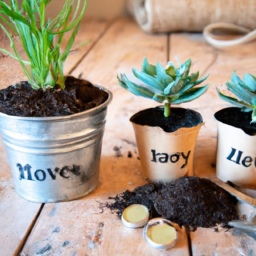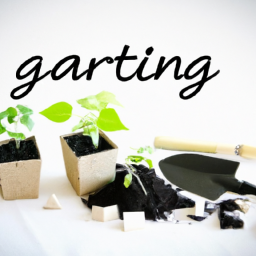
Hey there, plant lovers! Are you ready to dive into the world of sustainable planting and eco-friendly practices? In this blog post, we’ll explore the importance of adopting sustainable planting methods and how they contribute to a greener and healthier environment. Whether you’re a seasoned gardener or just starting out, this guide will provide you with valuable insights and practical tips to make your green space more sustainable. So, let’s get our hands dirty and discover the wonders of sustainable planting: eco-friendly practices!
Benefits of Sustainable Planting: Eco-Friendly Practices
Introduction
When it comes to gardening and planting, adopting sustainable practices is not only beneficial for the environment but also for our own well-being. Sustainable planting involves using eco-friendly methods that promote the health of plants, conserve natural resources, and minimize harm to the ecosystem. In this article, we will explore the numerous benefits of sustainable planting and how you can incorporate these practices into your own gardening routine.
Promotes Biodiversity
Sustainable planting plays a crucial role in preserving and enhancing biodiversity. By creating a diverse range of plants in your garden, you provide habitats and food sources for a variety of beneficial insects, birds, and other wildlife. This helps maintain a balanced ecosystem and supports the natural pollination process. Additionally, planting native species helps preserve local plant varieties and prevents the invasion of non-native species that can harm the environment.
Furthermore, sustainable planting practices such as companion planting, where certain plants are grown together to deter pests or enhance growth, can create a harmonious environment for different species to thrive. This promotes a healthy and vibrant garden ecosystem.
Incorporating sustainable planting methods not only benefits the environment but also adds beauty and interest to your garden as you witness the diversity of wildlife it attracts.
Conserves Water
Water scarcity is a growing concern in many regions of the world. Sustainable planting helps conserve water by utilizing efficient irrigation methods and choosing plants that are well-suited to the local climate. One such method is drip irrigation, where water is directly applied to the base of plants, reducing water loss through evaporation and ensuring that plants receive the necessary moisture.
Additionally, incorporating mulching techniques helps retain soil moisture by reducing evaporation. Organic mulches, such as wood chips or straw, not only conserve water but also improve soil health as they break down over time, providing nutrients to the plants.
By conserving water through sustainable planting practices, you not only contribute to the preservation of this precious resource but also reduce your water bills and create a more resilient garden that can withstand drought conditions.
Improves Soil Health
Healthy soil is the foundation of any successful garden. Sustainable planting practices focus on improving and maintaining soil health through organic methods. By avoiding the use of synthetic fertilizers and pesticides, you protect the beneficial microorganisms in the soil that contribute to its fertility.
One of the key practices in sustainable planting is composting. Composting involves recycling organic waste from your kitchen and garden into nutrient-rich compost that can be added to the soil. This improves its structure, water-holding capacity, and nutrient content. Compost also acts as a natural slow-release fertilizer, providing a steady supply of nutrients to plants over time.
Furthermore, sustainable planting encourages crop rotation, where different plant species are grown in a specific sequence to prevent the buildup of pests and diseases. This helps maintain soil health and reduces the need for chemical interventions.
By focusing on soil health through sustainable planting practices, you create a fertile and resilient garden that supports the growth of healthy plants.
Reduces Environmental Impact
Traditional gardening practices often involve the use of synthetic fertilizers, pesticides, and herbicides, which can have detrimental effects on the environment. These chemicals can leach into groundwater, contaminate rivers and lakes, and harm beneficial insects, birds, and other wildlife.
Sustainable planting, on the other hand, aims to minimize the use of harmful chemicals and instead focuses on natural pest control methods. This includes attracting beneficial insects such as ladybugs and lacewings, which feed on pests, and using physical barriers like nets or row covers to protect plants.
Furthermore, sustainable planting practices prioritize the use of organic and locally sourced materials, reducing the carbon footprint associated with transportation and manufacturing. By choosing native plants, you also reduce the risk of introducing invasive species that can harm the local ecosystem.
By adopting sustainable planting practices, you contribute to the overall health of the environment and minimize your ecological footprint.
Conclusion
Sustainable planting offers a multitude of benefits for both the environment and gardeners. By promoting biodiversity, conserving water, improving soil health, and reducing environmental impact, sustainable planting practices create beautiful, resilient, and eco-friendly gardens. So, embrace these practices and make a positive impact on the planet, one plant at a time!

Sustainable Planting: Eco-Friendly Practices
Implementing Eco-Friendly Practices in Plant Nurseries
Welcome to our guide on implementing eco-friendly practices in plant nurseries. In this article, we will explore various steps and strategies that can be adopted to ensure sustainable planting practices. By following these guidelines, you can contribute to the well-being of the environment while maintaining a productive and thriving nursery.
1. Use Organic and Sustainable Growing Methods
One of the fundamental steps towards sustainable planting in nurseries is to prioritize organic and sustainable growing methods. This involves avoiding the use of synthetic fertilizers, pesticides, and herbicides that can harm the environment and human health.
Instead, opt for organic alternatives such as compost, manure, and natural pest control methods. These substances not only provide essential nutrients to plants but also improve soil health and promote biodiversity.
Furthermore, consider implementing sustainable irrigation practices such as drip irrigation or rainwater harvesting systems. These methods minimize water waste and ensure that plants receive the necessary moisture without excessive usage.
2. Embrace Native Plants and Biodiversity
Another crucial aspect of eco-friendly practices in plant nurseries is the promotion of native plants and biodiversity. Native plants are adapted to the local climate, soil conditions, and wildlife, making them more resilient and less dependent on artificial inputs.
By growing and selling native plants, nurseries can contribute to the preservation of local ecosystems and support the habitat of native wildlife. Additionally, native plants often require fewer resources such as water and fertilizers, making them a sustainable choice for both the environment and gardeners.
Furthermore, encourage biodiversity by offering a diverse range of plant species in your nursery. This not only provides customers with more options but also helps create a balanced and resilient ecosystem. Consider including plants that attract pollinators, such as bees and butterflies, as they play a vital role in plant reproduction.
3. Reduce Waste and Recycle
Waste reduction and recycling are essential components of sustainable planting practices. Nurseries can adopt various strategies to minimize waste and promote recycling.
Start by implementing a composting system for plant waste, such as leaves, trimmings, and expired plants. Composting not only reduces waste sent to landfills but also produces nutrient-rich soil amendments that can be used in the nursery or sold to customers.
In addition to composting, encourage customers to return plastic pots and trays for recycling. Consider offering incentives, such as discounts or free plants, to motivate customers to participate in the recycling program. This helps reduce the demand for new plastic products and promotes a circular economy.
Furthermore, explore alternative packaging options, such as biodegradable or recyclable materials, to minimize the use of single-use plastics in your nursery.
By following these steps and embracing eco-friendly practices in plant nurseries, you can make a positive impact on the environment and inspire others to do the same. Remember, sustainability is a journey, and every small step counts towards a greener future!

Tips for Creating a Sustainable Garden: Eco-Friendly Planting Techniques
Welcome to the world of sustainable gardening! In this guide, we will explore eco-friendly planting techniques that will help you create a beautiful and sustainable garden. By following these tips, you can minimize your environmental impact while enjoying the beauty of nature right in your backyard. So, let’s dive in and learn how to create a sustainable garden!
Choose Native Plants
When planning your garden, consider using native plants. Native plants are well-adapted to the local climate, soil conditions, and wildlife. They require less water, fertilizer, and pesticides, making them an excellent choice for sustainable gardening. Native plants also provide food and habitat for local wildlife, helping to support biodiversity in your garden.
Before selecting native plants, research which species are indigenous to your region. Take into account the amount of sunlight, soil type, and water availability in your garden. By choosing the right plants for your specific conditions, you can create a thriving ecosystem that requires minimal maintenance.
When purchasing native plants, look for local nurseries or native plant sales. These sources often have a wide variety of native species and can provide valuable advice on their care and maintenance.
Practice Water Conservation
Water is a precious resource, and conserving it in your garden is essential for sustainability. Implementing water-saving techniques can significantly reduce your water consumption while keeping your plants healthy. Here are a few tips to help you conserve water:
1. Mulching: Apply a layer of organic mulch, such as wood chips or straw, around your plants. Mulch helps retain moisture in the soil, reducing the need for frequent watering.
2. Drip Irrigation: Install a drip irrigation system that delivers water directly to the plant roots. This method minimizes water loss through evaporation and ensures efficient water usage.
3. Rainwater Harvesting: Set up a rain barrel or a rainwater harvesting system to collect rainwater from your roof. You can then use this water to irrigate your garden during dry periods.
Implement Organic Pest Control
Controlling pests without the use of harmful chemicals is a key aspect of sustainable gardening. Organic pest control methods are not only safer for the environment but also promote a healthy balance of beneficial insects and wildlife in your garden. Here are a few eco-friendly pest control techniques:
1. Companion Planting: Planting certain flowers, herbs, or vegetables together can help repel pests. For example, marigolds can deter aphids, while basil repels mosquitoes.
2. Biological Controls: Introduce beneficial insects, such as ladybugs or praying mantises, to your garden. These insects feed on pests, helping to keep their populations in check naturally.
3. Homemade Remedies: Create your own organic pest control solutions using ingredients like neem oil, garlic, or soap. These natural remedies are safe for plants, humans, and the environment.
Practice Soil Health
Healthy soil is the foundation of a sustainable garden. By taking care of your soil, you can improve plant growth, reduce the need for fertilizers, and enhance water retention. Here are a few tips to promote soil health:
1. Composting: Start a compost pile or bin to recycle kitchen scraps, yard waste, and fallen leaves. Compost adds essential nutrients to the soil, improves its structure, and enhances its ability to retain moisture.
2. Crop Rotation: Rotate your crops each season to prevent the buildup of pests and diseases. This practice also helps balance nutrient levels in the soil, reducing the need for synthetic fertilizers.
3. Avoid Tilling: Minimize tilling or digging in your garden to preserve soil structure and prevent erosion. Instead, use techniques like sheet mulching or raised beds to create a healthy growing environment.
By adopting these eco-friendly planting techniques, you can create a sustainable garden that benefits both you and the environment. Remember to observe and learn from nature, as it is the best teacher when it comes to gardening. Enjoy the process, be patient, and watch your garden thrive while making a positive impact on the planet!
Key Takeaways
Sustainable planting is becoming increasingly popular as people become more aware of the environmental impact of their actions. By adopting eco-friendly practices, we can create beautiful gardens and landscapes while also protecting the planet. One of the key principles of sustainable planting is using native plants, which are well-adapted to the local climate and require less water and maintenance. These plants also provide habitat for local wildlife, supporting biodiversity in our gardens.
Another important aspect of sustainable planting is reducing the use of pesticides and fertilizers. Instead, we can rely on natural methods such as companion planting and organic fertilizers to keep our plants healthy and pest-free. This not only helps to protect the environment but also ensures that our gardens are safe for children and pets. Additionally, incorporating composting into our gardening routine can help reduce waste and provide nutrient-rich soil for our plants.
In conclusion, sustainable planting offers a win-win solution for both our gardens and the environment. By choosing native plants, reducing the use of chemicals, and practicing composting, we can create beautiful and thriving landscapes while minimizing our ecological footprint. Let’s embrace these eco-friendly practices and make a positive impact on our surroundings.
Frequently Asked Questions from our readers:
Q1: What is sustainable planting?
A1: Sustainable planting refers to the practice of growing and maintaining plants in a way that minimizes harm to the environment and promotes long-term ecological balance. It involves using eco-friendly techniques and materials to ensure the health and vitality of plants while reducing negative impacts on the ecosystem.
Q2: What are some eco-friendly practices for sustainable planting?
A2: There are several eco-friendly practices you can adopt for sustainable planting. These include using organic fertilizers and compost to improve soil health, conserving water through efficient irrigation methods like drip irrigation, selecting native plants that are adapted to the local climate and require less maintenance, practicing crop rotation to prevent soil depletion, and avoiding the use of harmful pesticides and herbicides.
Q3: Why is sustainable planting important?
A3: Sustainable planting is important because it helps protect the environment, conserve resources, and support biodiversity. By using eco-friendly practices, we can minimize soil erosion, reduce water pollution, and preserve natural habitats. Sustainable planting also promotes healthier and more resilient plants, which can contribute to improved air quality and mitigate climate change.
Q4: How can I incorporate sustainable planting in my own garden?
A4: You can incorporate sustainable planting in your garden by following a few simple steps. Start by assessing your soil and improving its health through organic amendments. Choose native plants that are well-suited to your region’s climate and require less water and maintenance. Implement efficient watering techniques like drip irrigation or rainwater harvesting. Avoid using synthetic fertilizers and pesticides, and instead opt for organic alternatives. Lastly, practice proper waste management by composting and recycling garden waste.
Q5: Are there any benefits to sustainable planting beyond environmental impact?
A5: Absolutely! Sustainable planting not only benefits the environment but also offers several additional advantages. It can enhance the aesthetic appeal of your garden by creating a natural and harmonious landscape. It can also attract beneficial insects and pollinators, which can improve overall plant health and increase yield in vegetable gardens. Additionally, sustainable planting practices can inspire and educate others about the importance of environmental stewardship and contribute to a sense of community and well-being.

Alex Turner is a sustainable gardening advocate and the founder of an acclaimed indoor gardening blog. With a focus on eco-friendly practices and urban sustainability, Alex combines his background in environmental studies with his love for plants to educate readers on mindful indoor gardening. His work highlights the importance of nurturing both plants and the planet.


